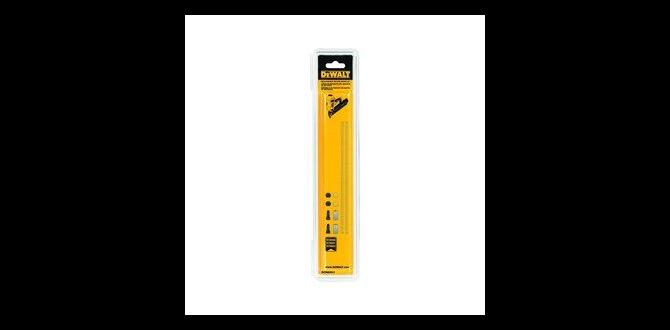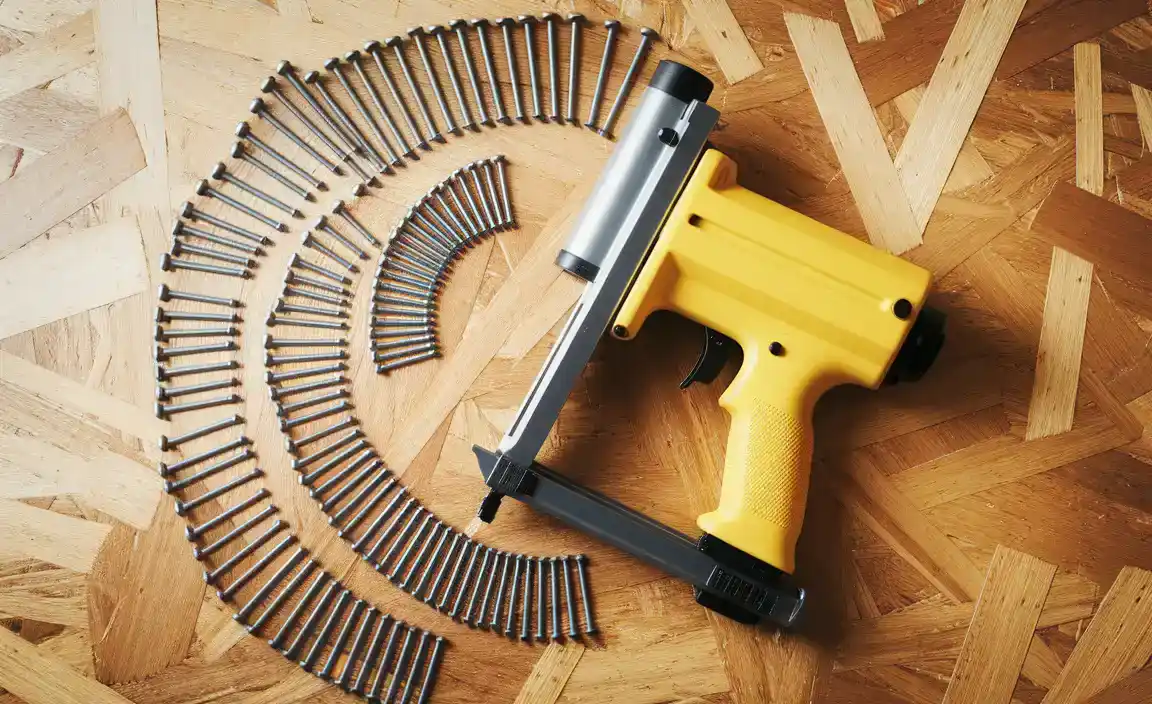Choosing the right nail gun for your fencing project dramatically speeds up installation and ensures a professional, sturdy result. For DIYers, consider pneumatic framing nailers for power and speed, or cordless options for ultimate portability. Ensure it handles the fastener size needed for your specific fence material.
Building a fence is a rewarding DIY project that can define your outdoor space and boost your property’s appeal. But let’s be honest, driving thousands of nails with a hammer can be exhausting and time-consuming! That’s where a nail gun comes in. It transforms fence building from a grueling chore into a much more manageable and even enjoyable task.
If you’re new to the world of nail guns, the sheer variety can be a bit overwhelming. What’s the difference between a pneumatic and a cordless nailer? What kind of fasteners does it use? And which one is truly best for fencing? Don’t worry, I’m here to help you navigate these questions. Think of me as your guide, Jack Shaffer, your friendly “Nailerguy,” ready to break down everything you need to know. We’ll look at the essential features, types of nail guns, and how to pick the perfect one for your fencing needs, ensuring you get the job done efficiently and safely.
Table of Contents
Why a Nail Gun for Fencing?
When you envision building a fence, you might picture a trusty hammer. And while a hammer has its place, for the sheer volume of nailing involved in fencing, a nail gun is a game-changer.
Speed: This is the big one. A nail gun can drive a nail in a fraction of a second. This means you can erect fence panels, attach rails, and secure posts much faster. What could take days with a hammer might take a single weekend with the right nail gun.
Consistency: Nail guns drive nails to a consistent depth every time. This leads to a much cleaner, more professional-looking fence. No more worrying about nails sticking out or being driven too deep.
Reduced Fatigue: Let’s face it, swinging a hammer repeatedly is hard work. A nail gun significantly reduces physical strain, meaning you can work for longer periods without getting tired. This is especially helpful on large fencing jobs.
Power: Many fence materials, especially deck screws for certain types of fences, can be tough to drive with a hammer. Nail guns provide the power needed to sink fasteners without pre-drilling in many cases.
Understanding Nail Gun Types for Fencing
Not all nail guns are created equal, and the type that’s best for fencing depends on your power source and specific needs. The main categories we’ll focus on are pneumatic (air-powered) and cordless.
Pneumatic Nail Guns
These are the workhorses of the construction world and are incredibly popular for fencing because of their power and reliability. They require an air compressor to operate.
How they work: A compressor stores and pressurizes air, which is then delivered to the nail gun via a hose. When you pull the trigger, a burst of this compressed air drives a piston, which in turn drives the nail.
Pros:
Lightweight: The nail gun itself is usually lighter than cordless models because the motor and battery are absent.
Powerful: They offer consistent, high power for driving nails into tough materials.
Durable: Often built for heavy-duty, continuous use.
Cost-effective (in the long run): While you need a compressor, the nail guns themselves can be less expensive than high-end cordless models.
Cons:
Requires an Air Compressor: This is a significant upfront investment and adds bulk/less portability.
Hose Management: The air hose can get in the way, snagging on things or limiting your reach.
Noise: Compressors can be quite loud.
Cordless Nail Guns
These nail guns offer the ultimate in portability and convenience, as they don’t require an air hose or compressor. They generally use either a battery and a gas cartridge, or just a battery and an internal mechanism.
How they work:
Propane/Gas Powered: A small disposable fuel cell (like Coleman fuel) is inserted, and a spark ignites the gas in a small combustion chamber. This explosion drives the piston and nail. A battery is used to power the fan that clears exhaust and drive the trigger mechanism.
Battery Powered (Electric or Fuel-Free): These use a powerful battery to spin a motor that drives a flywheel. When you pull the trigger, the flywheel spins rapidly and propels a piston to drive the nail.
Pros:
Ultimate Portability: No hoses means freedom of movement around your job site.
Convenient: Quick setup and no need to manage air hoses.
Good for smaller/medium jobs: Perfect for homeowners who aren’t doing large-scale commercial fencing.
Cons:
Heavier: Batteries and gas cartridges add weight to the tool.
Limited “Staples” per Charge/Cartridge: You might need to swap batteries or gas cartridges, which can interrupt workflow on very large projects.
Can be more expensive: The technology involved often means a higher upfront cost.
Power can vary: Some models may struggle with very dense hardwoods compared to pneumatic.
What Kind of Nailer for Fencing?
For fencing, you’re primarily looking at two types of nailers based on the fastener they drive: framing nailers and common nailers. While there are also brad nailers and finish nailers, these are designed for much smaller, finer work and aren’t suitable for the structural demands of fence building.
Framing Nailers
These are the most common choice for fencing. They are designed to drive larger, thicker nails (often called “framing nails” or “construction nails”) into wood.
Nail Size: Typically drive nails from 2 inches up to 3.5 inches long and .113 to .131 inches in diameter.
Power: They are powerful and can easily sink nails into pressure-treated lumber and hardwoods.
Why for Fencing: Perfect for attaching fence pickets to rails, securing rails to posts, and even for building fence panels.
Common Nailers
These are sometimes referred to as “session nailers” or “post/beam nailers.” They are essentially heavy-duty framing nailers designed for even larger fasteners.
Nail Size: Can drive larger and thicker nails, sometimes up to 3.5 inches or more.
Power: Built for the toughest jobs, like attaching large beams or structural components.
Why for Fencing: If you’re building very heavy-duty fences, like those using large timber posts and beams, a common nailer might be the best bet. For most residential fencing, a standard framing nailer is sufficient.
Important Note on Fasteners: Always check the recommended fastener type and size for your specific fencing materials and the nail gun you are considering. Many modern fence building guides will recommend screws for greater holding power and longevity due to the stresses fencing experiences (wind, expansion/contraction of wood). However, for sheer speed and volume, nail guns excel. If your project involves specific types of fasteners (like screws), you would need a screw gun or impact driver, rather than a nail gun. For this guide, we are focusing on nail guns for applications where nails are the preferred fastener.
Key Features to Look for in a Fencing Nail Gun
When you’re sifting through the options, keep these features in mind. They’ll help you narrow down your choices and pick the best tool for your fence job.
1. Power Source (Pneumatic vs. Cordless)
As discussed, this is your first big decision.
Pneumatic: Best for heavy-duty, continuous use if you have a compressor. Great for large jobs where you’ll be nailing all day.
Cordless: Best for portability and convenience, especially for smaller to medium-sized yards or if you don’t have a compressor. Consider the battery life and availability of extra batteries if you opt for this.
2. Nail Capacity and Type
Magazine Angle: This refers to the angle of the nail magazine (the part that holds the nails). Common angles are 15, 21, or 30 degrees.
15-degree (Coil Nailers): Usually hold more nails than stick nailers, making them good for very long, continuous work like siding or roofing underlayment. They can be a bit bulkier.
21-degree (Plastic Collated Stick Nailers): Very common for framing and fencing. They hold a good number of nails and are generally more compact than coil nailers. Plastic collation is also less likely to mar your wood compared to metal collation.
30-degree (Railed Stick Nailers): Hold fewer nails but are often very compact and allow you to get into tighter spaces.
Recommendation for Fencing: 21-degree framing nailers offer a great balance of nail capacity, tool size, and fastener availability for most fencing needs.
Nail Length Range: Ensure the nail gun can handle the length of nails you need for your fence posts, rails, and pickets. Most framing nailers can handle nails from 2 inches up to 3.5 inches, which covers most residential fencing applications.
3. Depth Adjustment
This is crucial for a professional finish. You want the ability to easily adjust how deep the nail is driven into the wood.
On-board Dial: Most modern nail guns have an easy-to-use dial or lever directly on the tool.
Why it Matters: You might want nails slightly countersunk (below the surface) for a cleaner look, or driven flush with the surface. Being able to adjust this on the fly is incredibly useful.
4. Firing Mode (Sequential vs. Contact Actuation)
Sequential Trip: You must press the safety contact tip against the wood first, then pull the trigger to fire a nail. This is the safer mode and ideal for precision nailing.
Contact Actuation (Bump Fire): You hold the trigger down, and then “bump” the safety contact tip against the wood to fire nails continuously. This is much faster but requires more control to avoid accidental firing.
Recommendation for Fencing: Many fencing tasks benefit from fast firing, so a tool with selectable actuation (meaning you can switch between sequential and contact) is ideal. For initial placement or when working near delicate surfaces, sequential is best. For fastening pickets rapidly, contact can be very efficient. Always start with sequential until you are comfortable.
5. Weight and Ergonomics
You’ll be holding this tool for extended periods, so comfort is key.
Weight: Pneumatic guns are generally lighter than cordless ones. Consider the overall weight and how it feels in your hand.
Grip: A comfortable, non-slip grip is important, especially if you’re working in damp or humid conditions.
Balance: How well the tool is balanced can make a big difference in reducing fatigue.
6. Jam Clearing
Nails can occasionally jam in the nail gun. A good tool will have an easy jam-clearing mechanism, allowing you to quickly remove obstructions without needing special tools. Tool-less jam clearing is a big plus.
7. Air Volume & Pressure (for Pneumatic)
If you go pneumatic, you’ll need to ensure your air compressor can keep up.
PSI (Pounds per Square Inch): Most framing nailers operate between 70-120 PSI. Check the tool’s requirements.
SCFM (Standard Cubic Feet per Minute): This is the volume of air the compressor can deliver. The nail gun will specify its SCFM requirement. You need a compressor that meets or exceeds this to keep the tool firing consistently without lagging. A general rule of thumb is that the compressor’s SCFM rating at 90 PSI should be around 1.5 to 2 times the nail gun’s SCFM requirement.
Choosing Your Nailer: A Comparison Table
Here’s a breakdown to help you visualize the pros and cons based on your likely needs.
| Feature / Type | Pneumatic Framing Nailer | Cordless Framing Nailer (Battery/Gas) |
| :————————- | :—————————————————— | :———————————————————– |
| Power Source | Air Compressor & Hose | Battery (and sometimes Gas Cartridge) |
| Portability | Limited by hose length and compressor location | Excellent, no cords or hoses |
| Weight | Lighter tool, but compressor adds bulk | Heavier tool due to motor/battery/gas |
| Nail Capacity | High (depends on magazine) | Moderate (depends on magazine; battery/gas might limit usage) |
| Consistent Power | Very High | High (can vary slightly with battery life) |
| Upfront Cost | Moderate (tool), High (compressor) | High (tool) |
| Running Cost | Low (electricity for compressor) | Moderate (electricity for charging, gas cartridges if applicable) |
| Best For… | Large, continuous jobs; professional use; budget-conscious (if compressor owned) | DIY, smaller yards, convenience, no compressor owner |
| Potential Drawback | Hose management, compressor noise/bulk | Tool weight, battery life/charging time, gas cartridge cost |
| Typical Nail Size (for Fencing) | 2″ to 3.5″ | 2″ to 3.5″ |
Putting It Into Practice: Step-by-Step Guide to Choosing
Let’s walk through the process of selecting your perfect fencing nailer.
Step 1: Assess Your Project Scope
How big is your fence? A small garden fence is different from a full perimeter fence around a large property.
How often will you use it? Is this a one-off project, or do you anticipate more DIY projects in the future?
What materials are you using? Standard lumber (pine, cedar, redwood) or dense hardwoods?
Step 2: Decide on Power Source
Already own an air compressor? A pneumatic nailer is a great, cost-effective choice.
No compressor and want maximum convenience? A cordless nailer is likely your best bet.
Concerned about battery life on long days? Consider pneumatic or a cordless system with multiple batteries.
Step 3: Determine Nailer Type and Size
Framing Nailer (21-degree) is typically the sweet spot for most residential fencing applications.
Verify Nail Length: Make sure the nailer’s capacity matches the nails needed for your fence pickets (usually 1.5″-2.5″) and rails (usually 2″-3″).
Consider a Common Nailer only if you’re using very large timbers.
Step 4: Check Essential Features
Depth Adjustment: Absolutely essential. Make sure it’s easy to use.
Selectable Actuation: Highly recommended for versatility (sequential and contact modes). Safety first!
Jam Clearing: Look for tool-less options for quick fixes.
Step 5: Read Reviews and Compare Brands
Once you have a general idea, dive into reviews for specific models. Look at reputable brands known for durability and performance. Sites like ToolReviews.com (example of an authoritative resource) often have in-depth comparisons and user feedback. Consider brands like:
DeWalt
Bostitch
Paslode
Hitachi/Metabo HPT
Senco
Milwaukee
Step 6: Consider Your Budget
Nail guns range from under $100 for basic pneumatic models to $400+ for high-end cordless ones. Factor in the cost of a compressor if going pneumatic. There are excellent options at various price points. Don’t shy away from slightly older or slightly less feature-rich models if they meet your core needs and fit your budget.
Safety First! Using Your Nail Gun Responsibly
Nail guns are powerful tools and must be treated with respect. Safety should always be your top priority.
Always Wear Safety Glasses: Impact-rated safety glasses or a full face shield are non-negotiable. Flying debris or ricocheting nails can cause serious eye injury.
Read the Manual: Every tool is different. Familiarize yourself with its specific operation, safety features, and maintenance requirements.
Understand Actuation Modes: Know when to use sequential and when contact actuation is appropriate. Always keep the safety tip depressed only when ready to fire.
Never point the nail gun at yourself or anyone else. Assume it’s loaded at all times.
Keep Fingers Away from the Trigger: Unless you are actively firing, keep your finger off the trigger and away from the trigger guard.
Secure Your Workpiece: Ensure the material you are nailing is stable.
Be Aware of Your Surroundings: Watch out for electrical wires or plumbing within posts or structures. Local building codes often have regulations about placement and depth of fasteners for structural integrity.
Disconnect Power When Not in Use: For pneumatic tools, disconnect the air hose. For cordless tools, remove the battery.
* Proper Maintenance: Keep your nail gun clean and well-maintained. Refer to your owner’s manual for lubrication and cleaning instructions.
Frequently Asked Questions (FAQ)
Q1: Can I use a framing nailer for fence pickets?
A1: Yes, a 2



